Tyrannidea • Alaudidae • Hirundinidae • Corvidae • Paridae • Sittidae • Certhiidae • Troglodytidae • Muscicapidae • Slyviinae • Turdinae
This list contains pictures of birds found on the official Louisiana Checklist. These birds were photographed within the state except where noted. Birds marked with an asterisk (*) are currently on the review list of the Louisiana Bird Records Committee.
Order PASSERIFORMESÂ
Family Tyrannidae - Tyrant Flycatchers
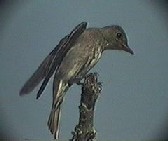
|
Olive-sided Flycatcher
Olive-sided Flycatchers are rare spring, and uncommon fall migrants. In the fall, they are among the earliest of migrant passerines, normally passing through the state in August and September. Although some sources list the lower mandible color as dark or horn, many of the fall migrants here have distinctly orange lower mandibles. Probably because of the extreme heat at the time of their fall passage, they also seem much sleeker than field guides suggest, and often perch with their mouths open, panting. |
| |
Western Wood-Pewee * |
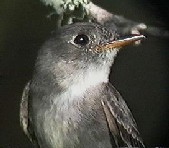
|
Eastern Wood-Pewee |
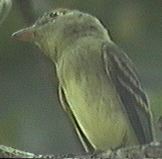
|
Yellow-bellied Flycatcher
Yellow-bellied Flycatchers are probably the easiest Empidonax flycatchers to identify (which isn't saying much). Their broad, yellow-orange lower
mandible separates them from all but Acadian and "Western" Flycatchers. They most resemble "Western"-type Flycatchers, being very
greenish above and yellowish below, but the eyering on Yellow-bellied is much less extensive than in Cordilleran or Pacific-Slope. The underparts of
Yellow-bellieds are distinctive as well, with a smudgy greyish-green wash over the chin, throat and upper breast, and yellow on the belly. There is also
a small spot of clear yellow showing through in the the middle of the throat. The head in profile sometimes shows a collapsed crest, as if the crown
feathers are too long to stand upright. Worn birds of course pose problems. |

|
Acadian Flycatcher
The Acadian Flycatcher is a big-billed Empidonax that resembles Yellow-bellied and "Western-type" flycatchers. It is usually paler and less
yellowish below than any of those species. Its bill is pale yellow beneath, compared to the bright orange-yellow of "Westerns". The malar
area of Acadians is a very pale green, paler than the crown and auriculars. The eyering is usually very narrow, and sometimes difficult to see. |
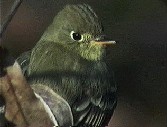
|
Alder Flycatcher |
| |
Willow Flycatcher * |
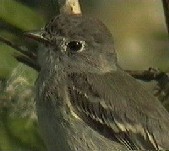
|
Least Flycatcher |
| |
Hammond's Flycatcher * |
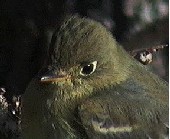
|
Pacific-slope Flycatcher *
The Pacific-slope Flycatcher, the West Coast representative of the "Western" Flycatcher superspecies, is a rarity in Louisiana. Standard
field marks for "Western", such as teardrop-shaped eyering, yellow-orange lower mandible and greenish upperparts coupled with yellowish
underparts still apply, but separating Pacific-slope Flycatcher from Cordilleran Flycatcher creates a new challenge. In terms of separating these two
species from their closest lookalikes, Acadian and Yellow-bellied Flycatchers, look for the distinctive eyering. |
| |
Cordilleran Flycatcher * |

|
Eastern Phoebe |
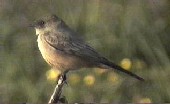
|
Say's Phoebe * |
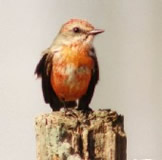
|
Vermilion Flycatcher
Why the Vermilion Flycatcher turns up in fair numbers in Louisiana every winter, well to the east and north of its breeding range, is a mystery. However,
at least a few dozen seem to be found every year in scattered locations around the state. Usually, the birds arrive in October and are found near bodies
of water surrounded by trees that offer perches for flycatching. Brightly colored adult males attract the most attention, but many of the less brilliant
females and young males (such as the one pictured here) also winter here. |
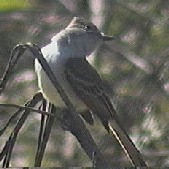
|
Ash-throated Flycatcher
Not too long ago, Ash-throated Flycatchers were assumed to be casual to rare in Louisiana, but with more birders now afield it has become apparent
that this species is regular in small numbers in the state each winter. Although it bears a resemblance to the summer resident Great Crested Flycatcher,
the two are generally not present at the same times of year. Another complication in identifying Ashthroats arises from the presence of the much rarer
Brown-crested Flycatcher. The more extensive, flaring dark tip to the otherwise reddish outer tail feathers (shown above) is the best clue when
identifying Ashthroats. |
| |
Great Crested Flycatcher |
| |
Brown-crested Flycatcher * |
| |
Great Kiskadee * |
| |
Sulphur-bellied Flycatcher * |
| |
Tropical Kingbird * |
| |
Couch's Kingbird * |
| |
Cassin's Kingbird * |
| |
Western Kingbird |
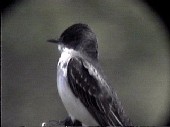
|
Eastern Kingbird |
| |
Gray Kingbird * |
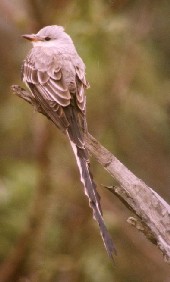
|
Scissor-tailed Flycatcher
The incredible Scissor-tailed Flycatcher can be found in Louisiana in all seasons: in summer as an uncommon breeder in scattered locations in the
western half of the state, as a fairly common spring and fall migrant, and even as a rare but regular winter resident. |
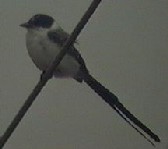
|
Fork-tailed Flycatcher *
The Fork-tailed Flycatcher can finally be crossed off of the "next birds to be found in LA" lists! On Nov. 15, 1996, Gary Broussard
happened upon the bird pictured here, in Vermilion Parish, about 11 miles south of Crowley. |
Family Alaudidae - Larks
Family Hirundinidae - Swallows
| |
Purple Martin |
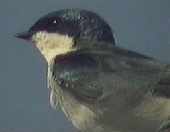
|
Tree Swallow |
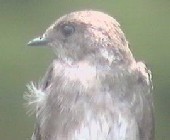
|
Northern Rough-winged Swallow |
| |
Bank Swallow |
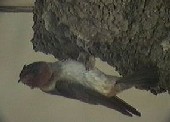
|
Cliff Swallow |
| |
Cave Swallow * |
| |
Barn Swallow |
Family Corvidae - Jays, Crows
| |
Blue Jay |
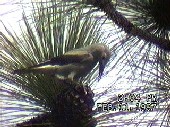
|
Clark's Nutcracker *
A new bird was added to the state list when Mac Myers, Curt Sorrells, and Phillip Wallace went out on February 9, 1997, to search the pines for crossbills and found a Clark's Nutcracker instead. There were apparently a number of eastwardly extralimital records in the winter of 1997, including at least 5 records from Texas, and one report from as far east as Iowa. |
| |
American Crow |
| |
Fish Crow |
Family Paridae - Titmice
| |
Carolina Chickadee |
| |
Tufted Titmouse |
Family Sittidae - Nuthatches
| |
Red-breasted Nuthatch |
| |
White-breasted Nuthatch |
| |
Brown-headed Nuthatch |
Family Certhiidae - Creepers
Family Troglodytidae - Wrens
| |
Rock Wren * |

|
Carolina Wren |
| |
Bewick's Wren |
| |
House Wren |
| |
Winter Wren |
| |
Sedge Wren |
| |
Marsh Wren |
Family Muscicapidae - Muscicapids
Family Slyviinae - Kinglets and Gnatcatchers
| |
Golden-crowned Kinglet |
| |
Ruby-crowned Kinglet |
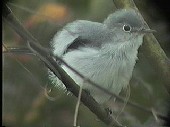
|
Blue-gray Gnatcatcher |
Family Turdinae - Thrushes
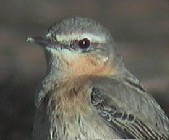
|
Northern Wheatear * |
| |
Eastern Bluebird |
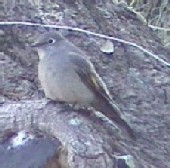
|
Townsend's Solitaire * |
| |
Mountain Bluebird * |
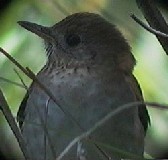
|
Veery |
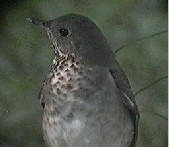
|
Gray-cheeked Thrush
Gray-cheeked Thrushes migrate through the state in spring and fall, but are much more common in the fall. Gray-cheeked is a heavily spotted thrush, with
the spotting especially dense and dark from the chin to the juncture of the throat and breast, and then becoming dense but very diffuse down to the level
of mid-breast. Gray-cheeked Thrush is a species that can be confusing for a number of reasons, starting with the fact that it most often frequents shaded
areas where poor lighting can make field marks hard to discern. Gray-cheekeds resemble a few other thrushes as well, although in most cases ID is
straightforward given a good look.
In Louisiana, this species migrates alongside Swainson's Thrush and Veery. Gray-cheeked lacks the buffiness that permeates the sides of the face of
Swainson's and shows through in the area of the eye-rings and lores. As a matter of fact, Gray-cheeked barely shows an eye-ring (if it all), and
the eye-ring when present looks dull grayish. Veery is usually tawnier above, but the much fainter pattern of spotting on the underparts of Veery is
the biggest difference between the two species. One caveat: A mystery thrush that turned up in Cameron Parish in late October 1995 was tawny above, as
in Veery, lacked the buffy face of Swainson's, was fairly heavily spotted below as in Gray-cheeked. Reaction was mixed among birders present. Many
felt it must be a Bicknell's Thrush, or a rusty example of a Gray-cheeked. Closer examination of the bird showed that it had the distinctly
pale-centered dorsal feathers of a juvenile bird, and the conclusion was finally reached that it was a juvenile Veery.
One ID problem that few in Louisiana consider is separating Hermit from Gray-cheeked Thrush. Hermit, a common winterer in the state, usually arrives
late in fall and leaves early in the spring, with little overlap between it and the other migrant thrushes. Still, a few Hermits do linger late in
spring and can be seen in the woods with Gray-cheekeds. Both are heavily spotted below, but seen head-on, Gray-cheekeds are generally more heavily
marked on the throat than Hermit, which usually is a fairly unmarked white between its distinct malar streaks. The rustier tail vs. mantle of the
Hermit is of course a diagnostic field mark on birds seen from behind, but I have seen a few Hermits whose tails didn't contrast a great deal
with their backs. |
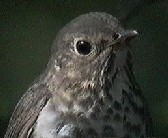
|
Swainson's Thrush
Swainson's Thrush is a common migrant through the state in spring and fall. Among the group of thrushes with spotted breasts, the Swainson's is
among the easiest to ID, by the suffusion of buffiness on its auriculars, eye-ring, and lores. Generally the buffiness and the eye-ring are fairly easy
to see; while on Gray-cheeked Thrushes you may think that you see an eye-ring, on a Swainson's, it's almost always obvious. Swainson's is
also generally warmer brown above than Gray-cheeked. It can be told from Hermit Thrush by face pattern, lower contrast between tail and mantle color,
and from Veery by its more heavily spotted underparts. |
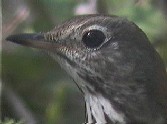
|
Hermit Thrush |
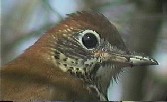
|
Wood Thrush |
| |
American Robin |